By Doug Larson
Some readers will remember seeing first-run episodes of such westerns on television as The Rifleman and Gunsmoke. A common firearm seen in most of them is the lever action gun. And back in the days depicted in these television shows and in western movies, the lever action was used for hunting, shooting fun, contests, and self-defense. It was versatile and effective, and it still is.
Like the modern rifles of today – the AR-15 being the most common example – the lever gun was chambered for a variety of cartridges. And even though technology has advanced and semi-automatic rifles and carbines are common, the lever gun is still a viable platform. And it is great fun to shoot.
It may not have the magazine capacity of an AR-15 and it is not self-loading nor can it be fired quite as fast, but with the proper techniques and practice, it is very fast to shoot, accurate, and has enough magazine capacity to hold its own in most life-or-death encounters. Although there are exceptions, most such incidents are at close range where iron sights are adequate and the number of rounds fired is few.
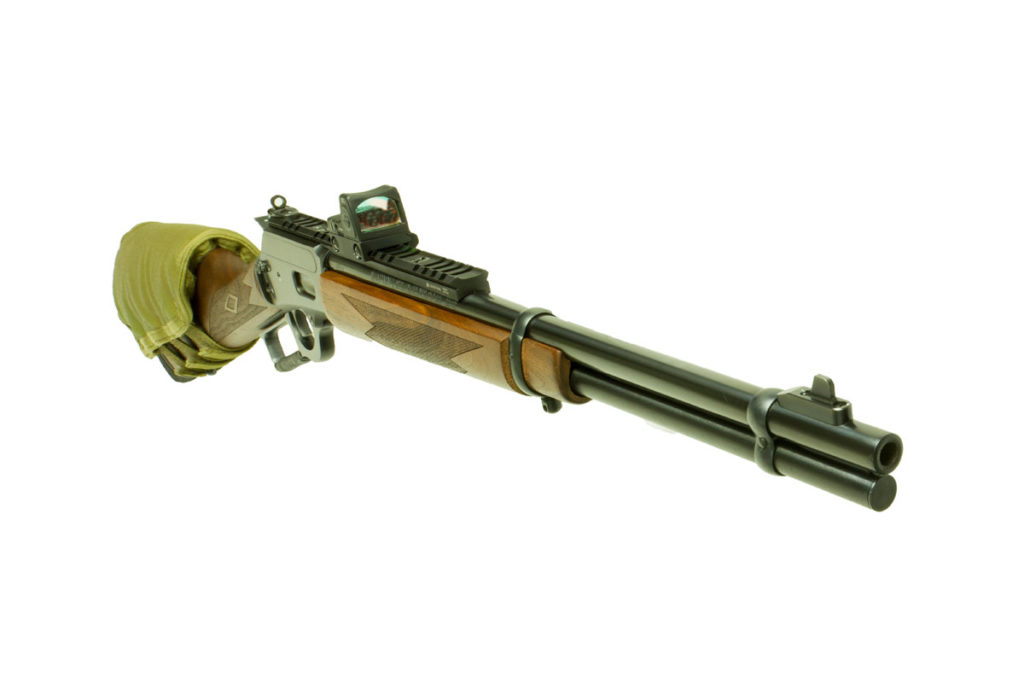
The design of this Marlin 1894c is faithful to the original design, but with some modern updates. To make it even more useful for personal defense in the 21st century, improvements include a Lever Rail, ghost ring rear and post front sight from XS Sights along with a Trijicon RMR red dot sight. The padded cheek rest has been added to raise the shooter’s eye to the level of the RMR. (Doug Larson photo)
The versatility of lever guns became obvious when a group of gun writers and experienced shooters recently met at Gunsite Academy located near Prescott, Arizona for a three-day class using lever action rifles and carbines. Taught by experienced Gunsite instructors and range masters, Lew Gosnell, Ed Head and Gary Smith, the basics as well as the finer points of gun handling and marksmanship with the lever gun were presented and practiced until all students gained a satisfactory level of competence.
So, why would anyone consider using a lever gun instead of an AR-15 for any task these days? Well, unfortunately, some readers live in jurisdictions where the possession or use of the modern rifle – the AR-15 – is infringed. But in some of those same jurisdictions, possession, and use of a lever action gun is not. After all, it’s just a “cowboy” gun and does not bring to mind the irrational fear that some people feel at the mere sight of an AR-15. In times of civil unrest, it can be very effective for use as a defensive tool, and in fact, I know of at least one law enforcement officer, when he found himself in just such an environment, armed himself with a lever gun for that very reason.
But proper training and then practice are – as they are with all firearm self-defense skills – required for the lever gun to be effective. A major problem though is finding the right training. Despite the increase in defensive firearms training instructors and schools, only a very few have expertise with lever guns. A quick Internet search revealed that of the few that offer lever action courses, only one appears to offer classes that are more than a few hours long. That’s Gunsite Academy, the oldest and the most prestigious privately owned firearms training center in the world.
CURRICULUM
First and foremost, do not kid yourself. You cannot learn how to properly run a gun and fight effectively with it from watching a video, reading a book or reading this article. There is no substitute for quality instruction and then practicing techniques the right way while an experienced instructor watches and immediately corrects any errors. And the first step in learning is to realize you probably don’t know that there are things you don’t know. To give you a flavor of the instruction available, here are some of the things taught at Gunsite.

To gain competence, accuracy and speed, Gunsite classes practice shooting on the square range at various distances while instructors observe, coach and correct. (Doug Larson photo)
Safety is the most important consideration and is constantly emphasized. The four rules of gun safety are introduced at the beginning of class after which the instructors get immediately into the meat of the course, starting with carry techniques. A sling on a long gun is like a holster for a handgun. It gives the shooter a way to safely carry the gun hands-free. But getting a rifle or carbine into use from sling carry can be slow and dangerous if not done correctly.
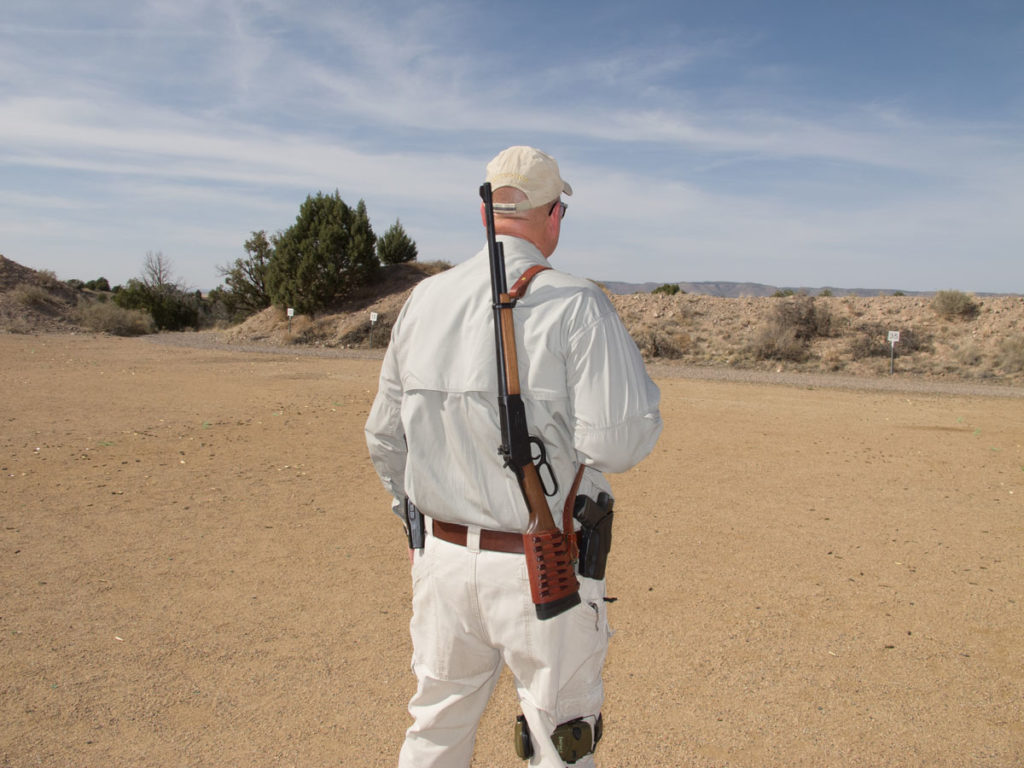
Gunsite instructor and range master Lew Gosnell demonstrates the American method of carrying a rifle on a sling. (Doug Larson photo)
There is more than one way to carry a gun on a sling, so American and African carry were demonstrated. Then the proper way to put the gun quickly into action from both carry methods was taught and practiced. Galcomakes a fine sling called the Riflemann Sling which I used during the class. Another good sling maker is Andy’s Leather.
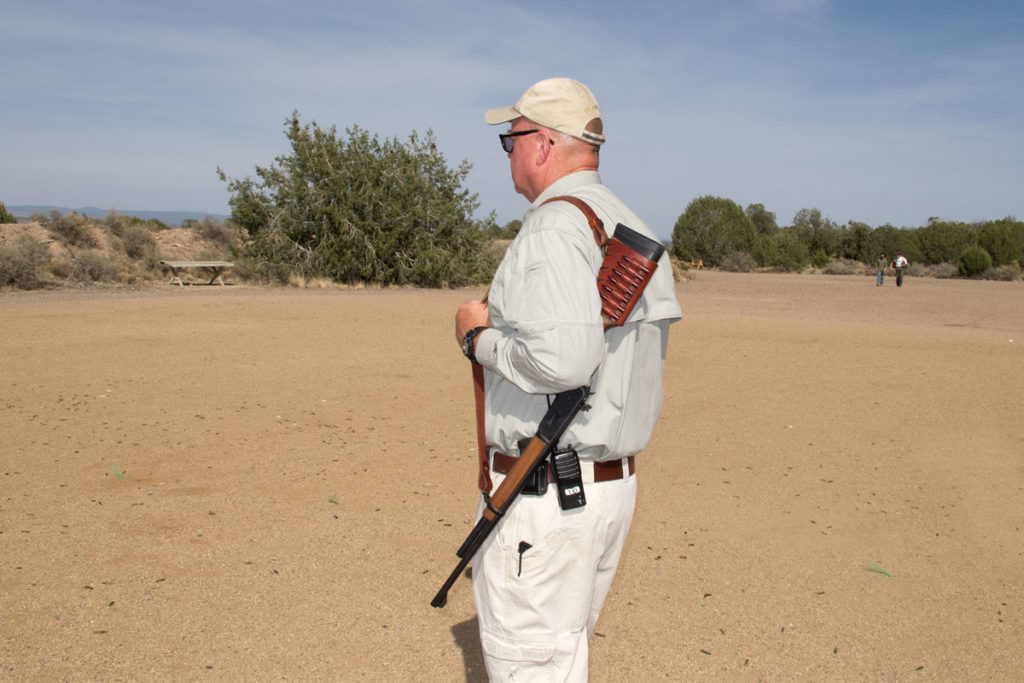
This is what African carry with a sling looks like as demonstrated by Gunsite instructor and range master Lew Gosnell. (Doug Larson photo)
Sometimes the lever gun may be carried in the hands in a low ready or high ready position. Controlling where the muzzle is pointed and then shouldering the gun and getting off a shot safely and quickly requires proper technique. Students practice these skills slowly at first, then faster so speed and accuracy improve.

The lever gun at the low ready. This is a field position used for scanning and assessing threats, shown here by Gunsite instructor and range master Lew Gosnell. (Doug Larson photo)
Having the ability to shoot the lever action gun from different shooting positions is important. These include standing, speed kneeling, braced kneeling, sitting and prone. During the course, I used Alta Industries elbow and knee pads for protection when kneeling or shooting prone and was glad I had them.
When carrying the lever gun, it is common to have a round chambered and the action on safe or the hammer at half cock. While some lever guns like the modern Marlins have a safety button on the receiver below the hammer that is pushed from right to left to disengage, others have no safety button but rely on a safety or half cock hammer position. With either setup, when carrying the gun in the hands, the thumb of the trigger hand should always be positioned on the hammer so that when the gun is brought up to aim, the hammer can be quickly cocked. For Marlins that have the safety, it can be pushed off at the same time. When lowering the gun and the threat is gone, the safety – if there is one – and the hammer should be moved to the safe position. All of this must be done often in practice so that the actions become automatic.
A feature of some lever guns is the tubular magazine that is located beneath the barrel. Other lever guns have a box magazine below the receiver. For guns with a tubular magazine, there may be a loading port located forward on the tube which is opened by pulling an inner magazine tube forward so that cartridges can be dropped in. Some tubular magazine lever guns have a loading gate on the side of the receiver which makes keeping the magazine full easier and loading faster.
With side loaders, if you shoot one round, load one round. If you shoot two rounds, load two rounds. That keeps the magazine full, ready for any threat. When topping off the magazine, keep the gun shouldered and eyes scanning for danger. But if the magazine is empty and there is no time to refill it, the lever gun is not out of the fight. With the action open, a round can be dropped into the receiver – either through the ejection port in the case of a Marlin or through the top of the action for a Winchester – the action closed and the round fired.
Regardless of the lever gun design, having spare rounds where they are easily and quickly available to load and shoot is a must. And dropping the rounds in a pocket will work, but it is not the best way to carry spares. A much better way is with a belt or belt slide with cartridge loops which keeps the ammunition oriented for fast and easy retrieval. I used belt slides made by Simply Rugged Holsters (www.simplyrugged.com) and which proved to be of excellent quality.
An alternative to loops on the belt is a similar device with cartridge loops that are made of cloth or leather and that attaches to the buttstock. An example is the Ammo Caddy from Versacarry.
Follow up shots can be delivered very rapidly with a lever gun. It just seems natural to cycle the lever after firing a round, and because the trigger, or control hand, does not have to be removed from the lever loop, time is saved. Be sure though that the lever is cycled with force completely in both directions because short stroking it can cause malfunctions. As soon as the shot is fired, the lever should be worked without removing the gun from the shoulder or lifting the head off the stock. These skills – loading, cycling the action, shouldering the gun from a slung position or a hand carry position and shooting – should be practiced slowly at first, adding speed as the shooter gets used to the activity. It takes hundreds of repetitions before gun handling becomes automatic.
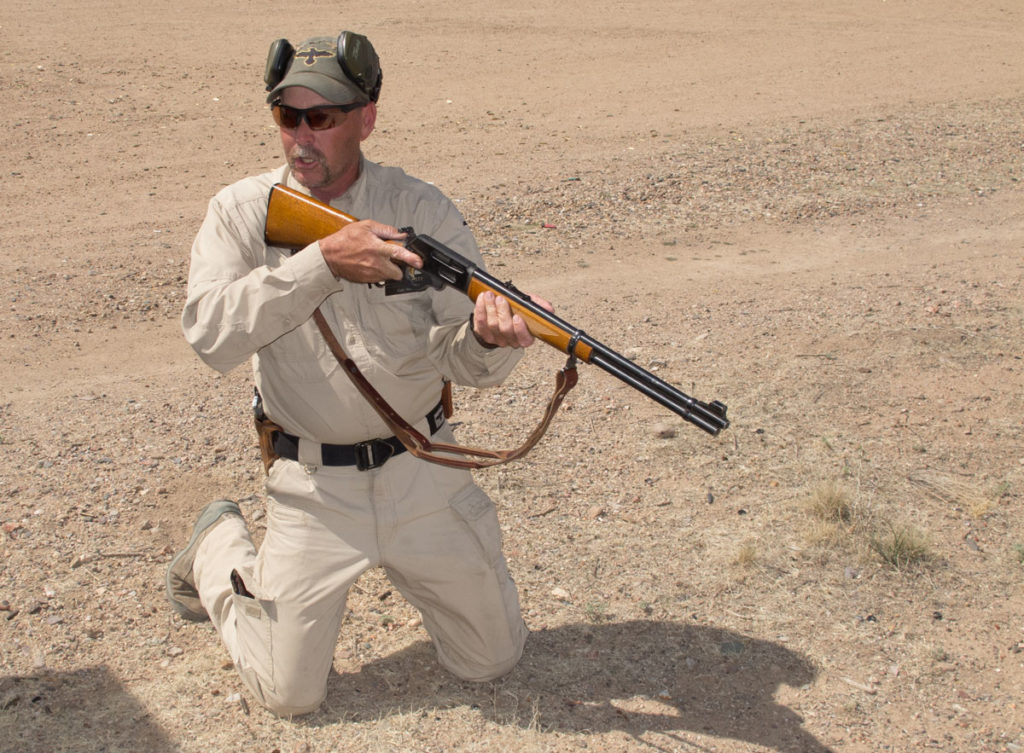
The double kneeling position demonstrated here by Gunsite instructor and range master Gary Smith is a very versatile position for use behind cover or concealment. (Doug Larson photo)
GUNS AND EQUIPMENT
Lever guns are made to chamber many different calibers from .22 up to cartridges capable of stopping any animal likely to be encountered on the North American continent. Whether you need protection against grizzly bears or criminals, there is a lever gun that will work. Some of the most popular chamberings are .30-30 Winchester and the pistol calibers – like .45 Colt, .44 Magnum, and .357 Magnum. Then there are lever guns chambered for old favorites like the .45-70 Government and high power rifle cartridges. And if you want something a little different, Big Horn Armory builds some very high-quality lever guns in .500 S&W Magnum.
Many people who shoot lever guns prefer one chambered in a pistol caliber. Recoil is modest compared to high power rifle calibers, but ammunition is less expensive and a pistol can be carried that is chambered for the same cartridge. This is one of the reasons that pistol caliber lever guns were so popular in the early days. Although a pistol caliber lever gun can be a good choice for self-defense and it increases the range of the pistol cartridge, it does not have the range of a rifle caliber gun. Hornady has helped to narrow the gap though.
Several years ago, Hornady introduced its LeverEvolution line of ammunition designed to increase the range and usefulness of ammunition used in lever guns. With a soft pointed polymer tip that will not detonate the primer of a cartridge in front of it, it can be used in a tubular magazine. And the ballistic coefficient is improved. This and modern powders increase velocity and the useful range of pistol caliber lever guns.

Speed kneeling is demonstrated by Gunsite instructor and range master Gary Smith. The position is very fast to assume and recover from. (Doug Larson photo)
For part of the Gunsite class, I used .357 Magnum Hornady LeverEvolution ammunition which more than doubled the effective range to nearly 200 yards. For short range practice, I used Doubletap .38 Special ammunition which is more economical and produced less recoil. But a special magazine follower from Beartooth Mercantile had to be installed to work with the pointed LeverEvolution ammo. To spot hits on targets during training, a good set of binoculars helps and I used a MeoStar B1 10×32 set from Meopta.
Not long ago, Mossberg introduced a lever gun with a futuristic appearance and features that permit some modern accessories to be mounted on the gun. The Mossberg 464 SPX Lever Action rifle’s appearance will assault the eye of traditionalists but brings the lever gun into the modern world. It has a tactical appearing buttstock that is adjustable for length of pull and comb height, as well as a forend that is equipped with Picatinny rails allowing the attachment of a light or laser.
But even the very traditional Marlin lever action rifle can be updated despite its loyalty to the original design from the late 1800s. XS Sights makes a Picatinny rail called the Lever Rail that can be installed permitting the use of a scope or red dot sight like the Trijicon RMR that I used during the class. The Lever Rail also has a ghost ring rear sight and white line front blade that replaces the buckhorn rear and hooded ramp front sight that comes stock on the Marlin. These changes greatly improve the speed of target acquisition.
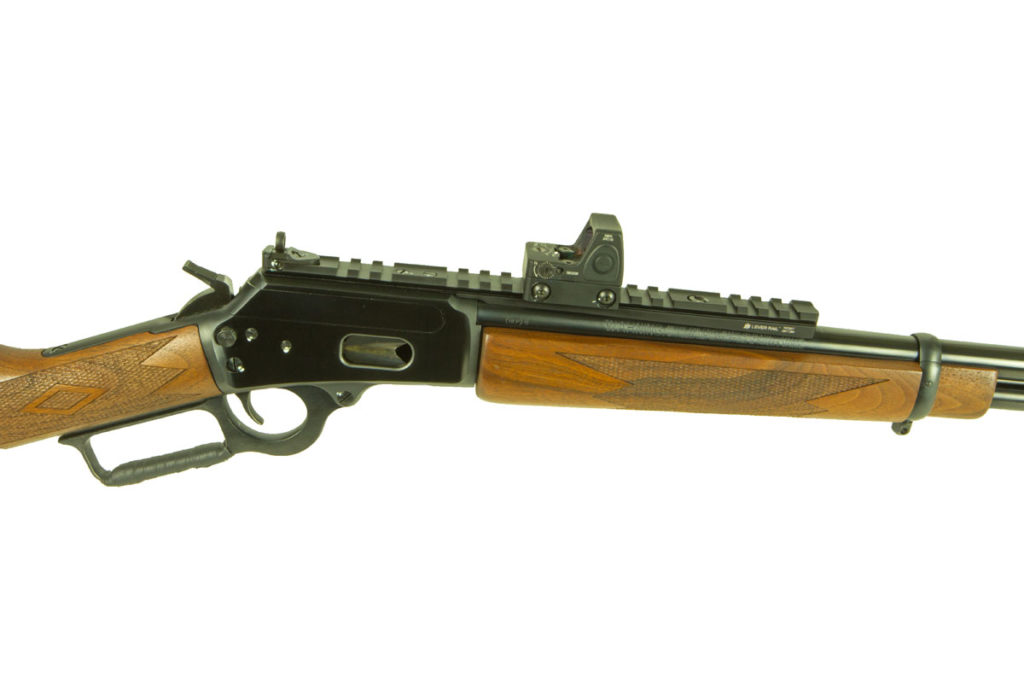
The XS Sights Lever Rail is easily installed on this Marlin 1894 chambered in .357 Magnum. No alteration of the gun is required and the rail permits the use of a variety of modern optics. (Doug Larson photo)
And for those savvy shooters who appreciate the benefits of ghost ring sights, Skinner Sights makes an excellent ghost ring, or peep, sight for a variety of lever guns.

XS Sights makes a front post with white line that greatly increases the speed of sight acquisition. (Doug Larson photo)
Don’t dismiss lever action rifles and carbines for self-defense. They are not outdated relics of the old west. These guns, even without modern accessories or design changes, but with the right training, can be a great alternative for personal protection.
***Shop GunsAmerica for your next lever action rifle***
A former Contributing and Field Editor for Guns & Ammo magazine, Doug Larson’s articles have appeared in many top firearm publications. He has completed hundreds of hours of firearm and self-defense training provided by some of the finest world class gun fighting instructors and schools. He has experience with handguns, rifles, shotguns, submachine guns, machine guns and other crew served weapons.


For the folks saying a levergun is obselete for combat, that is absurd. Ive run a winchester 94 in 357 mag through several CQB courses at Storm Mountain. My times were as good or better than guys running ARs or PCC’s. The only place I was lacking was during reloads (for obvious reasons). However, during CQB I rarely emptied the 12 rds mag tube. If I did, I transitioned to my sidearm which was a S&W TRR8 (8rd 357 mag). Ive qualified Grandmaster in 3 out 4 courses. A 357 mag coming out of a 20″ barrel gets mighty close to 30-30 power inside 100 yards. Now, once your working outside 125 yards the accuracy and power fall of quickly however in modern urban combat or home defense its a moot point
I find it funny that someone would pay for lessons to shoot firearms. You point, shoot and don’t move the firearm- lol. Better off spending your money on ammo to practice with.
There are always people trying to charge you for something you don’t need to pay for- LMAO
That is a very ignorant statement as… becoming proficient in working an action , pulling the trigger and hitting your target is a completely different animal if you have never trained to deploy your weapon in a stress fire situation.
Train train train…. muscle memory is a must as the act of firing a weapon is a perishable skill.
Enjoyed the article having carried both ways when stalking WT. Consider this if you will a white tail is very sensitive to movement. Un slinging either carry method is a LOT of movement. Here is what I did starting last season. Just like the military slings their AR style rifles. Over the neck, under one shoulder hanging right in front of your chest. It hangs right there your hand is resting on the action, it balances perfectly. You can not unlike a AR just let it go or slide it your side. I shoot right hand but also carry a 460XVR on my left side in a bandolier holster. The AR sling is of a bungy cord design …….. pulls right back to your shoulder. I now carry all of my log guns in this manner. 45-70 lever action, muzzle loader, turkey shotgun and AR eagle. Did a little challenge with a couple of hunt club members, of course they “ha ha ha” when they first saw my set up. Ok guys let’s try something (a target was already set from “O”ing a day before). So we were both sanding looking at the target, one guy yelled go ………………… I was on target and sent a round before he shoulder his rifle, he did get off his round the same time I sent my second. Works for me with considerably less movement. Can’t post a image of my setup on the Henry 45-70, wish I could.
I was taught as a kid how to shoot by the late LTC Ellis Lea, USA (Ret.) Ellis who was a West Virginia State Trooper prior to entering the US Army during WWII. Ellis used the 94 Winchester on the job as a lawman. After WW2 he accompanied the first US advisors which went into South Vietnam to perform an internal security survey for then-President Eisenhower and served as a law enforcement instructor for the USAID Office of Public Safety, teaching small arms and small unit tactics for various foreign clients as directed by USAID.
The factory open sights of the pre-1964 Winchester Model 94 in .30-30 came zeroed from the factory to strike within a 3 inch circle drawn tangent at 6:00 inside a 6 inch black aiming bull at 50 yards. The normal sight picture with open sights is to take a “fine” bead in which the front sight is drawn all the way into the small rear notch, using the bead to take a 6:00 hold on the bull, using factory loads, with the sight elevator set on its lowest notch.
Each step on the open rear sight elevator increases the zero range by approximately 50 yards. Raising the open rear sight into its second notch with the correct height of front sight height should be 100 yards, the third notch 150 yards, and the 4th notch 200. Again, this is using a “fine” bead, drawn down completely into the small notch, taking a 6:00 hold.
When using the factory semi-buckhorns for quick combat range estimation, the shoulders of an FBI silhouette or Army “E” target approximately fill the width of the small notch at about 100 yards or meters. If you can see daylight around the shoulders of the silhouette, alter your sight picture so that the bead “floats” above the fine notch. When the bead is held level with the first shoulder inside the buckhorn above the inner notch, point of impact approximately coincides with the center of the bead at 200 yards. Proper sight picture then is to hold for center of mass of the silhouette. Receiver peep sights with bead front and ghost ring aperture should be zeroed to strike 3 inches high at 100 yards, to provide a point of aim = point of impact hold at 150 yards, hitting in the lower half of the F silhouette at 200 yards.
At longer ranges raising the front sight relative to sight picture so that the bead “floats” between the top ears of the semi-buckhorn open sight, the bead subtends the height of the silhouette and provides correct elevation to approximately 300 yards or meters. Using this sight picture with a good initial zero, firing factory loads, a trained rifleman can average 80% hits or better on the Army “F”, “D” or “E” silhouettes at 200 yards and 60% hits or better at 300 yards. Fired in this manner a .30-30 lever action has similar hit probability to the SKS and is a bit better than typical AK platforms when used beyond 100 yards.
What type rifles were used at your Gunsite session? I’d like to learn how they functioned and if there were any preferences afterwards, or lessons learned, specifically comparing Marlins vs Winchester. Thanks.
The comment made by ‘mauser6863’ about comparing the Garand to a Lever Gun is an apple vs oranges arrangement. A fast handling carbine, employed in most CQB situations is to be preferred over a full size Battle Rifle. I have 6 lever guns and the only rifle caliber long gun I have left is an old Remington pump in 30-06…even that only has an a 22″ bbl, so it is still pretty ‘weildable’, but I am not aware of any ‘Tactical’ 30-06 ammo useable in CQB…
Got a 39A, 1894SS,1895CBA,336 and a Win 94. Wouldn’t hesitate to use any of them for self defense. Yes I have several of the Dreaded Black Rifles in .223 and .308. In out and out combat would prefer the .308 light weight AR. But for general self defense the 1894SS in .44mag or 336 in .30-30 would be great! There’s a difference between a rifle needed for self defense and a rifle needed for End of Times Armageddon! Levers are are fun, accurate and nastalgic to shoot and I’m glade they are still popular. My 1895 CBA is a Remlin and very well made……..kudos to Remington for uping their game and making their guns in the U.S.A. instead of running off to China, Brazil or Bumfuk Egypt!
I went to a couple of CAS matches and really enjoyed watching them compete. I will add that they used VERY light loads in the revolvers and lever action rifles. Not sure how they would fare with full power loads?
A couple of matches, at one club is not a good sampling. I’ve been in SASS for 20 years and I use standard 1870s 1880s level loads. Some “gamers” use what we refer to as mousefart loads, but in any trophy match; local, state, regional or national they are not allowed. When in competition I use 1866s and 1873s: their simpler actions are the fastest, but when I’m in the woods I use a ’92 if I want to use magnum power pistol ammo, or ’94 or ’95 if I want rifle caliber power, In either case, I’m still nearly as fast as I am with my competition guns.
I have owned and carried lever action rifles for most of my life. As a Sheriffs Deputy I kept a model 94 Winchester in my patrol car, and called on it from time to time. My favorite lever gun is still the Winchester M-88 in 308, which I’ve used to kill deer, elk, and moose. With a 10 round magazine and scout scope it would be a formidable “social” weapon.
I had an old marlin 1894 in 44 magnum 30 years ago and wish I never let it go.
Great article on the Craft of the Lever Gun class Doug!
When I see a lever gun with a rail and red dot, I think of the first car I saw with fender skirts and a continental kit. Yuck! Still functional for home protection, but not optimal. Personal preference at best. Love the levers.
Well, I hope everyone had fun at the class.
Simple fact is that the lever gun is obsolete for combat use. Yes, you can use it to defend yourself, if that’s all you are allowed or can afford, etc. However it is less than ideal.
I believe (correct me if I’m wrong) that the M1 Garand is still 50 state legal and represent a far, far better choice than a lever gun for just about any purpose. If you hate the length and weight, some gunsmiths offered, “Tanker” version that were a little shorter and a little lighter. Eight rounds of 30-06 delivered semi-automatically out of a military proven platform beats any lever gun ever made for anything.
While the M1 Garand is obsolescent, it not obsolete and can perform adequately, if needed and you aren’t allowed by your slave masters to possess modern weapons like an AR15, which is a far, far better choice than a M1 Garand.
What type rifles were used at your Gunsite session? I’d like to learn how they functioned and if there were any preferences afterwards, or lessons learned, specifically comparing Marlins vs Winchester. Thanks.
If you want to see a lever gun run really fast watch any Cowboy Action video.We have members at our SASS club that can get 10 shots off in around two seconds hitting multiple steel targets at about 10 yards.Great game and people,check it out.
You beat me to it, John. CAS is the way to learn to run a lever gun.
Yup! Just what I was about to suggest. Way cheaper that traveling so far, as there are many SASS clubs in almost any community. The folks that like that sport are also the kind that will welcome any newbie to shooting, and tuck you under their wind to make you feel at home. It is probably one of the best ways to get introduced to shooting today!
I find the Achilles heel on these rifles is the wrist on the grip which I repair often as a gunsmith from people falling on them. I’ll repair and re-enforce the stock with epoxy and a piece of steel all-thread inside the wrist area and it makes / keeps it strong for future use. Other than that I love lever action rifles. Even the big 45-70 guide guns. Smooth and accurate. Now if we could just keep people from falling on them.
I use a marlin 336 in 30/30 and before that a Winchester 1894 in 30/30. Works well up to moose with a calm shot
You left out the very best lever gun, the browning BLR It can do far more than any of the others.
My son shot a 74# hog two weeks ago with an old Marlin 336 30-30 at 75 yards. One shot drop.
For fun and practice of good shooting and accuracy skills, I love Cowboy Action Shooting. There are sanctioned matches aplenty. My Winchester 94 in 45 Colt works well to learn good technique and how to run the firearm effectively, for whatever purpose it is used.